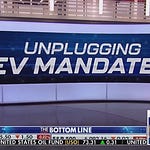House Votes to Repeal California’s 2035 Gas Car Ban: What’s Next?
By Lauren Fix
The U.S. House of Representatives moved one step closer Thursday to overturning a federal waiver that allows California to enforce a ban on gasoline-powered vehicles by 2035. The waiver, granted by the Environmental Protection Agency (EPA) under former President Joe Biden, had sparked opposition from automakers, fuel producers, and even President Donald Trump.
The House voted 246-164 in favor of a measure to repeal the EPA authorization, which enables California to set stricter emissions standards than federal guidelines, aiming to boost sales of electric vehicles and other zero-emission cars.
The legislation now heads to the Senate, where lawmakers have until mid-May to decide on the repeal. However, this may require overriding a ruling by the Senate parliamentarian, who determined that the repeal cannot proceed under the Congressional Review Act (CRA), a special legislative procedure that Republicans are using to undo Biden-era policies.
The congressional vote on the CRA follows a series of actions by the Trump administration to reverse Biden’s environmental policies while promoting fossil fuels. On Wednesday, the House passed additional measures to roll back EPA waivers on zero-emission truck sales and nitrogen oxide pollution from heavy-duty engines.
California’s 2035 ban on gasoline cars, introduced in 2020 by Governor Gavin Newsom, is part of the state’s effort to cut greenhouse gas emissions by more than 50% from light-duty vehicles by 2040. The ban is expected to impact 17 other states that have agreed to follow California’s lead, including New York and Washington. In a statement, Governor Newsom criticized the House vote, stating that “big polluters” influenced Republicans and that they ignored legal advice.
Newsom's opponents, include automakers such as Toyota, and trade groups like the U.S. Chamber of Commerce and SEMA, argue that California’s requirements are unrealistic and would drive up car prices, limit consumer choice, and exacerbate the impact of existing tariffs on imported vehicles and auto parts.
The repeal effort faces additional hurdles in the Senate. Despite a recent ruling from the Senate parliamentarian that the California waiver cannot be rescinded under the CRA, Republicans are pushing forward with the repeal.
However, Senate Republicans will need a simple majority to override the parliamentarian’s ruling, which could prove challenging, particularly with moderate GOP senators. If the repeal fails, the EPA would have to undo California’s emissions rules administratively, potentially leaving the state’s zero-emission standards in place for years.
And there's more good news: Transportation Secretary Sean Duffy revealed during today’s cabinet meeting with President Donald Trump that he plans to rewrite existing fuel economy standards for SUV and trucks in order to bring down vehicle costs.
Toward the top of the meeting, Duffy pointed to the fuel standards finalized by the National Highway Traffic Safety Administration (NHTSA) under the Biden administration, which required all light-duty vehicles to average 50.4 miles per gallon by 2031. SUVs and pickups were averaging around 35 miles per gallon at the time the rules were finalized. These standards were just one aspect of the previous administration’s push for an accelerated deployment of electric vehicles and its goal of lowering vehicle-related emissions.
Duffy said: “We are going to rewrite those standards, bring it down to something that is far more reasonable,”said, adding that the new rules will help lower domestic vehicle prices.
During Trump's day-100 cabinet meeting, Energy Secretary Chris Wright advocated for increasing exports of liquefied natural gas (LNG) and criticized the Biden administration’s efforts to slow new export terminals.
In January 2024, the Biden administration had put a pause on approvals for new LNG export projects, in order to conduct a study on the environmental and economic impacts of increased exports. Trump signed an executive order on his first day in office reversing that pause and since then the Energy Department has issued several permit extensions and approvals for more exports.
Wright has predicted that LNG could become the largest U.S. export “in the next few years.” Exports of LNG are expected to jump in the coming months as several nations like Japan, South Korea, and members of the EU have expressed interest in increasing their imports from the U.S.. LNG may even become a critical bargaining chip for other nations looking to get around Trump’s sweeping tariffs later this year.
Interior Secretary Doug Burgum continues to stand by the administration’s plan to use public lands for energy development – a move that will likely shrink protected federal lands and waters.
Earlier this month it was revealed that the Department of the Interior was reviewing the boundaries of several national monuments to see whether their lands had any potential for mining or oil production. Burgum appeared to confirm that the administration plans to do this for most federal lands and waters, saying the department is working to “identify the balance sheet of America.”
In a statement Burgum said: “We’re treating our natural resources like the American balance sheet they are. And America’s resources – the 700 million acres of surface that’s public, 700 million of subsurface, the 2.5 billion offshore – all contain what we need to have self-sufficient supply chains.”
For trucks, lawmakers will vote on a California rule requiring heavy-duty vehicle manufacturers to increase the sales of zero-emission trucks. They will also vote to overturn a state regulation that aims to reduce nitrogen oxide emissions from heavy-duty vehicles. Both of these regulations were granted waivers by the Environmental Protection Agency to set more stringent emission standards.
Republicans have used the CRA to attempt to undo the Biden administration’s energy regulations. The special legislative process allows lawmakers to bypass the filibuster and vote in a simple majority.
However, the Government Accountability Office (GAO) said last month that waivers relating to the Clean Air Act are not considered agency rules but instead an adjudicated order, therefore it would not subject to the CRA. But on April 30, the Senate passed Senate Joint Resolution 31, the Curtis EPA Emission Reclassification Congressional Review Act (CRA), by a vote of 52 to 46. This is very important because it means lawmakers have a path forward to removing California’s power.
One more vote is need. If the EPA rule is be repealed, the EPA would be barred from issuing a substantially similar rule in the future unless authorized by Congress. This could mean California it’s carveout, and release the American people from it’s oppressive and nonsensical rules.
A spokesperson for the California Air Resources Board told the Washington Examiner in a statement: “By using the Congressional Review Act, the Trump EPA is doing what no EPA under Democratic or Republican administrations in 50 years has ever done, and what the U.S. Government Accountability Office has confirmed does not comply with the law.”
It is unclear whether legal challenges will arise from the House’s efforts to overturn the California waivers.
Since entering office, Trump and Republicans have set their sights on regulations, particularly those in California that look to bolster the electric vehicles industry and reduce gas powered vehicles. Republicans have argued that California’s emission rules set a de facto national standard and force consumers to transition towards electric vehicles.
We will be watching for the Senate Vote S.J. Resolution 31 which will be the joint resolution to nullify the Environmental Protection Agency rule and remove the electric vehicle mandate. Make sure to follow us.
You can support me by buying me a cup of coffee. Thanks for subscribing and your support! https://www.buymeacoffee.com/laurenfix
Looking for more automotive news?
https://www.CarCoachReports.com
Total Car Score Podcast ► https://www.revolverpodcasts.com/shows/total-car-score/
















Share this post